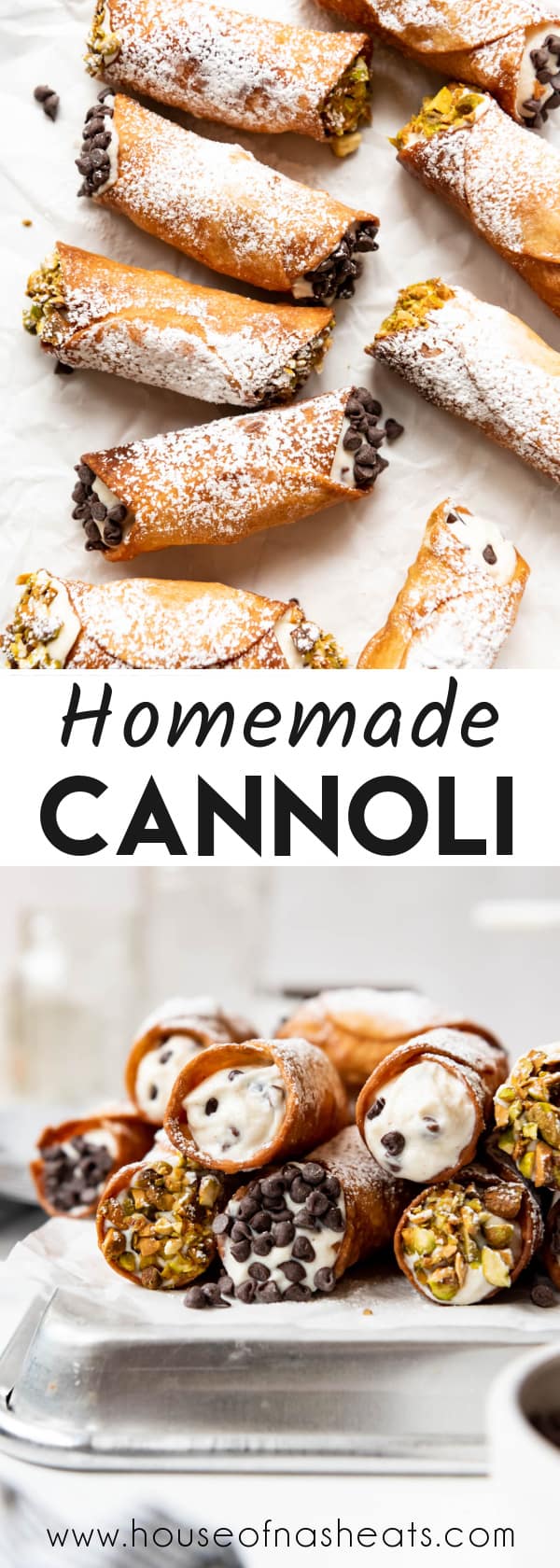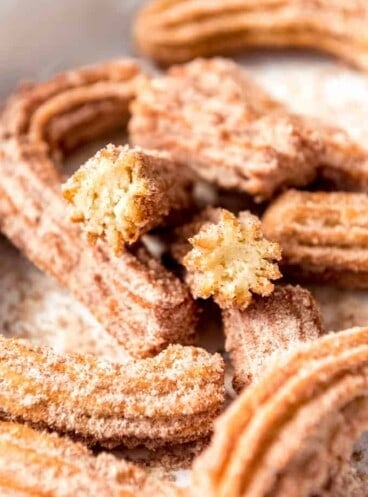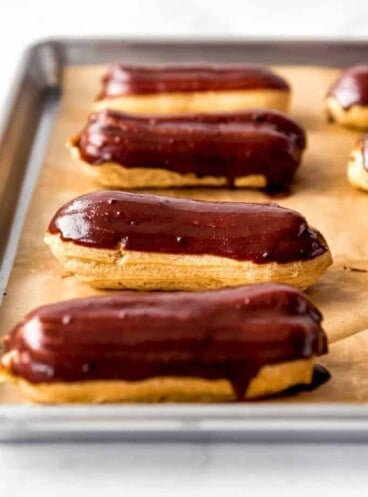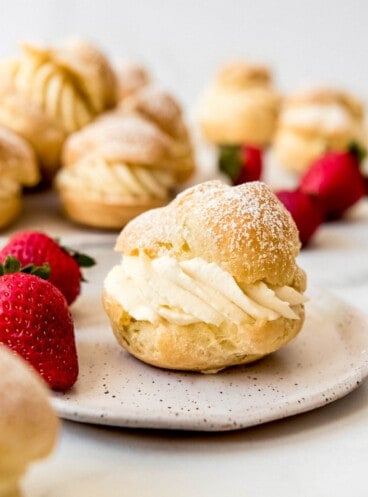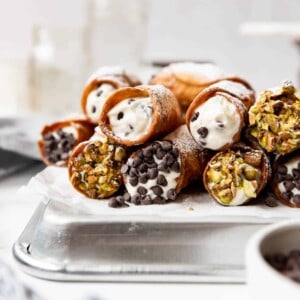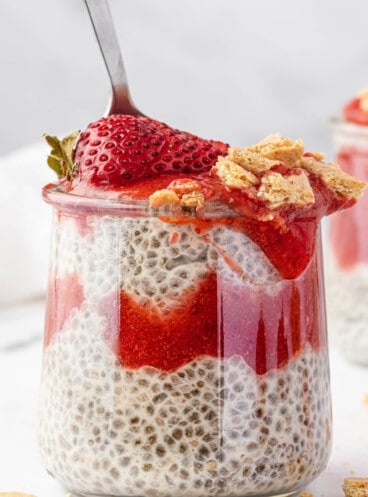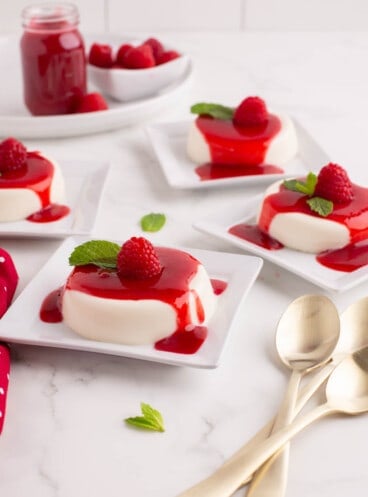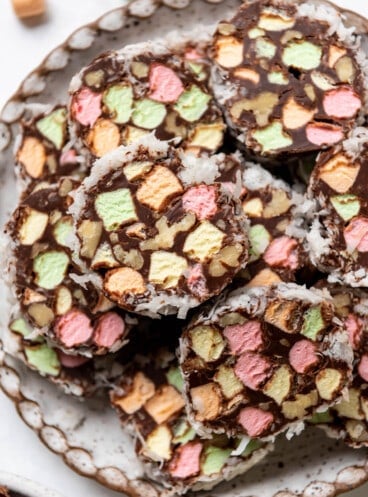This Homemade Cannoli recipe makes deliciously crisp, lightly spiced pastry shells filled with a warming and sweet homemade ricotta filling made with vanilla, cinnamon, and mini chocolate chips!
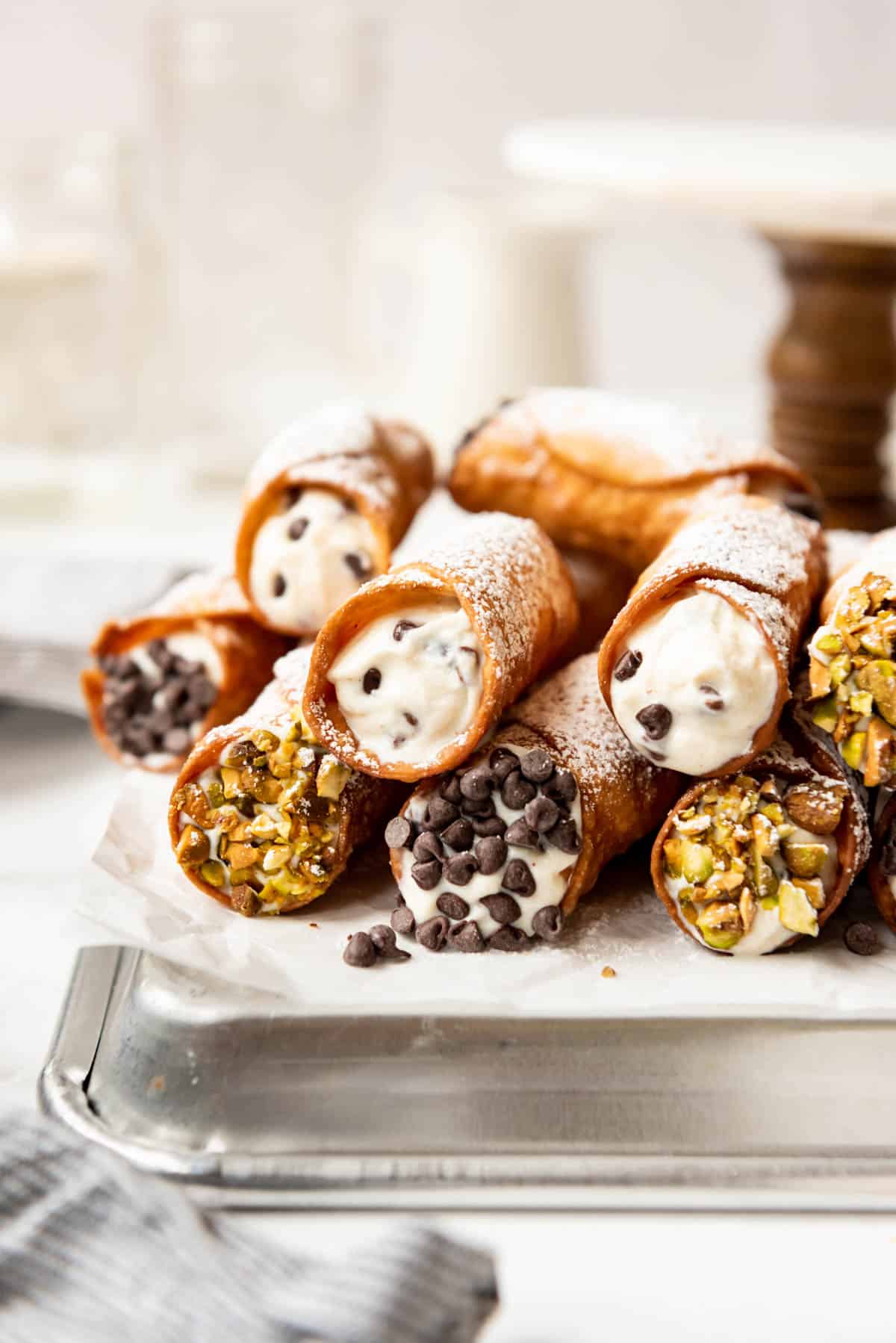
Table of Contents
If you LOVE authentic cannolis but don't have anywhere near you to get them, then this recipe will become your new best friend! The shells achieve a golden brown perfection, providing a satisfying crunch that perfectly complements the smooth, sweet filling.
I used to eat cannoli all the time when I lived in New Jersey. They're one of my favorite treats and the good ones were easy to find at bakeries nearby.
I've found it's harder to come by really good cannoli in California, so I have resorted to making them at home from scratch, and it's easier than you'd think!
Homemade cannolis have a special charm that store-bought versions often lack. The ritual of crafting the shell and folding in the creamy ricotta filling is a labor of love that pays off with each bite.
This simple recipe guides you through creating both the crunchy shell and the creamy ricotta filling, ensuring that even special occasions can be graced with this Italian dessert without much fuss. By adding orange zest or lemon zest, you invite a subtle, refreshing citrus note that brightens the creamy ricotta cheese filling.
Whether you're a seasoned baker or trying your hand at Italian pastries for the first time, this easy cannoli recipe promises the best results, tempting you to say "delizioso" with every bite!
For more homemade Italian chocolate treats, try my Cannoli Dip, Chocolate-Dipped Almond Biscotti, and my Homemade Nutella!
Why We Love This Recipe
- Get creative and change the flavor of your cannoli filling to suit your preferences.
- You can save some time if you need to and you can use store-bought pastry shells if you prefer!
- This recipe is surprisingly easy; you'll just need to plan your time well in order to chill the dough and cannoli filling long enough for the best results.
What You'll Need
Scroll down to the recipe card below this post for ingredient quantities and full instructions.
- Flour - All-Purpose Flour is the best flour to use for the base of the shells in this cannoli recipe.
- Granulated Sugar - Sweetens the dough for a balanced, dessert-worthy shell.
- Cinnamon - Adds a subtle warm spice to the shell pastry and filling.
- Salt - A pinch to enhance all the flavors of the cannoli shell.
- Butter - The key to a flaky pastry shell is to use cold butter!
- Eggs - Eggs bind the dough together, and the egg white is used to seal the dough around the cannoli forms.
- Sweet Marsala Wine - Traditional to Sicilian cannoli, Marsala adds a unique flavor and the right moisture to the dough.
- Oil - For frying, use vegetable or peanut oil, providing a high smoke point to achieve that golden brown without burning.
- Ricotta Cheese - This is the heart of the filling, so choose good-quality ricotta cheese for the best results. We'll be straining it to ensure the filling is creamy and not watery.
- Powdered Sugar - This sweetens the filling and adds a smooth texture.
- Vanilla Extract - Offers a classic, sweet background note to the filling. Use my Homemade Vanilla Extract or the store-bought stuff.
- Zest - Use fresh lemon or orange zest to add a fresh, citrusy brightness to the creamy filling.
- Chocolate Chips - Use semi-sweet chocolate chips to balance the flavors and add a bit of chocolatey indulgence to every bite.
- Pistachios - Adds a nutty crunch and a touch of color.
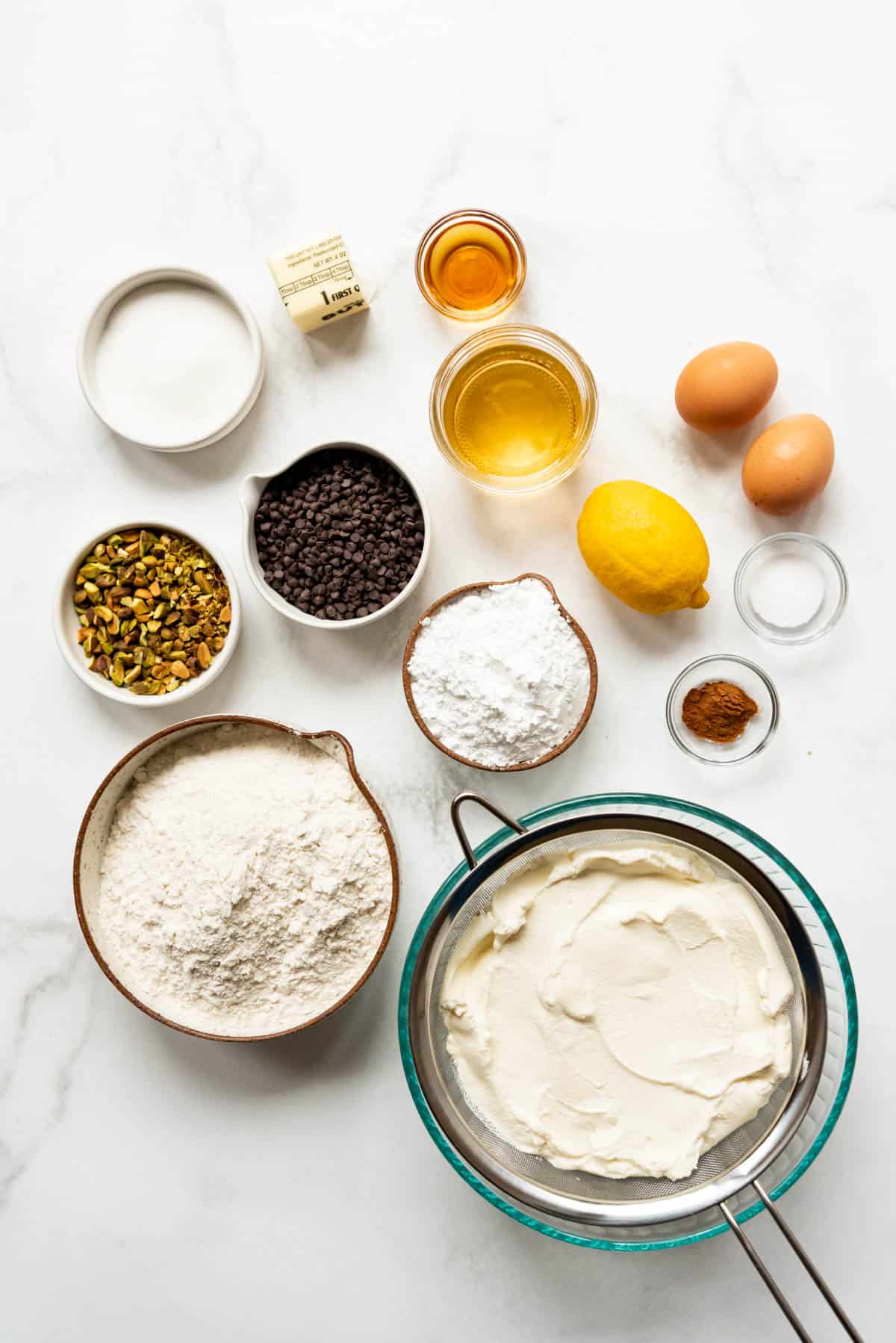
Strain the Ricotta Cheese
Start this cannoli recipe by straining your ricotta cheese. If the ricotta is quite thick, you can usually get away with just spreading out a couple of layers of paper towels, spreading the ricotta cheese on top, covering it with more paper towels, and then pressing out excess moisture.
For runnier ricotta cheese, place a fine mesh sieve over a large bowl. Line it with cheesecloth. Add ricotta cheese and spread it into an even layer. Cover with plastic wrap and let it strain for at least 30 minutes but more like 6 to 8 hours or overnight if you have the time. Discard the liquid in the bowl and use the strained ricotta cheese. That's it!
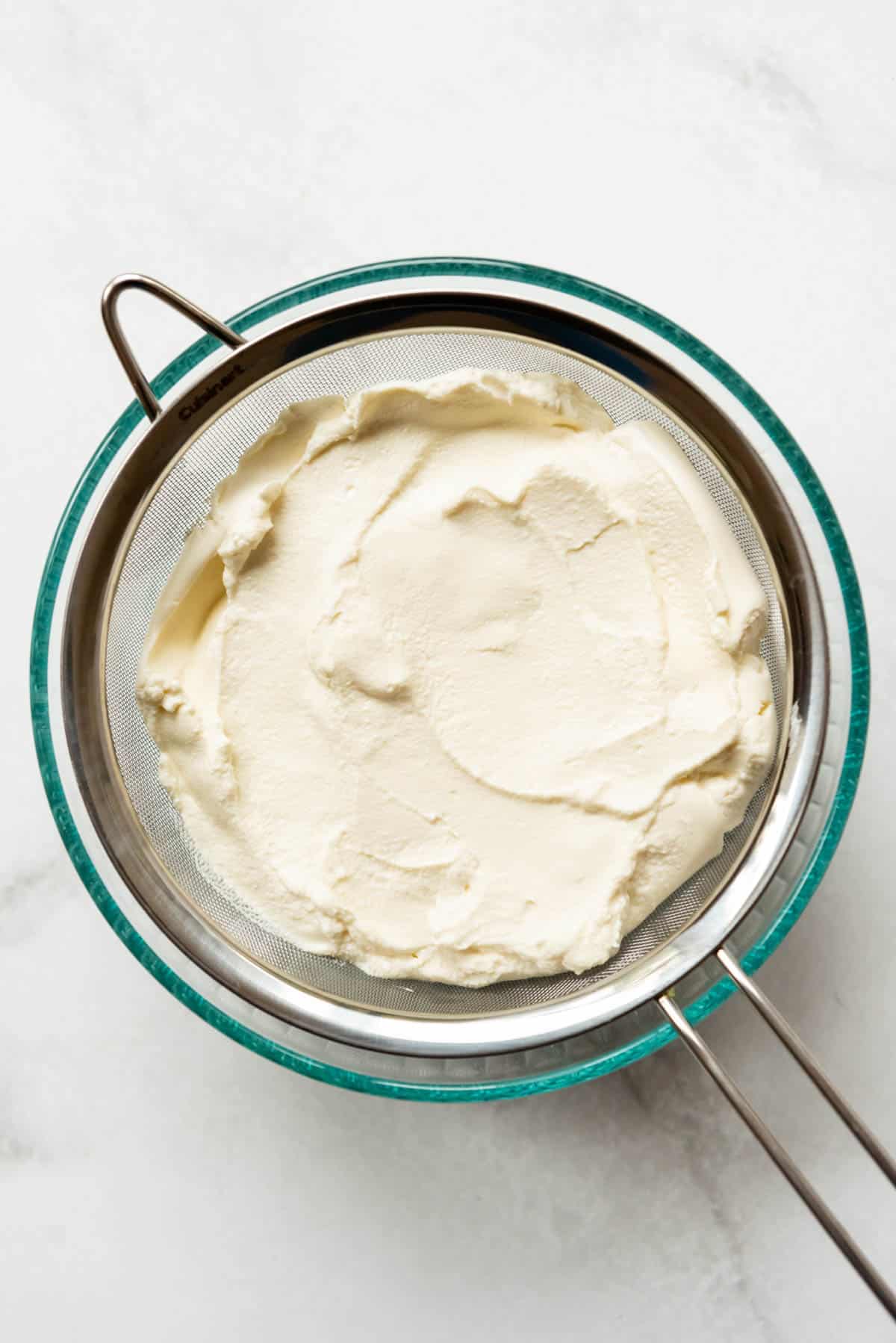
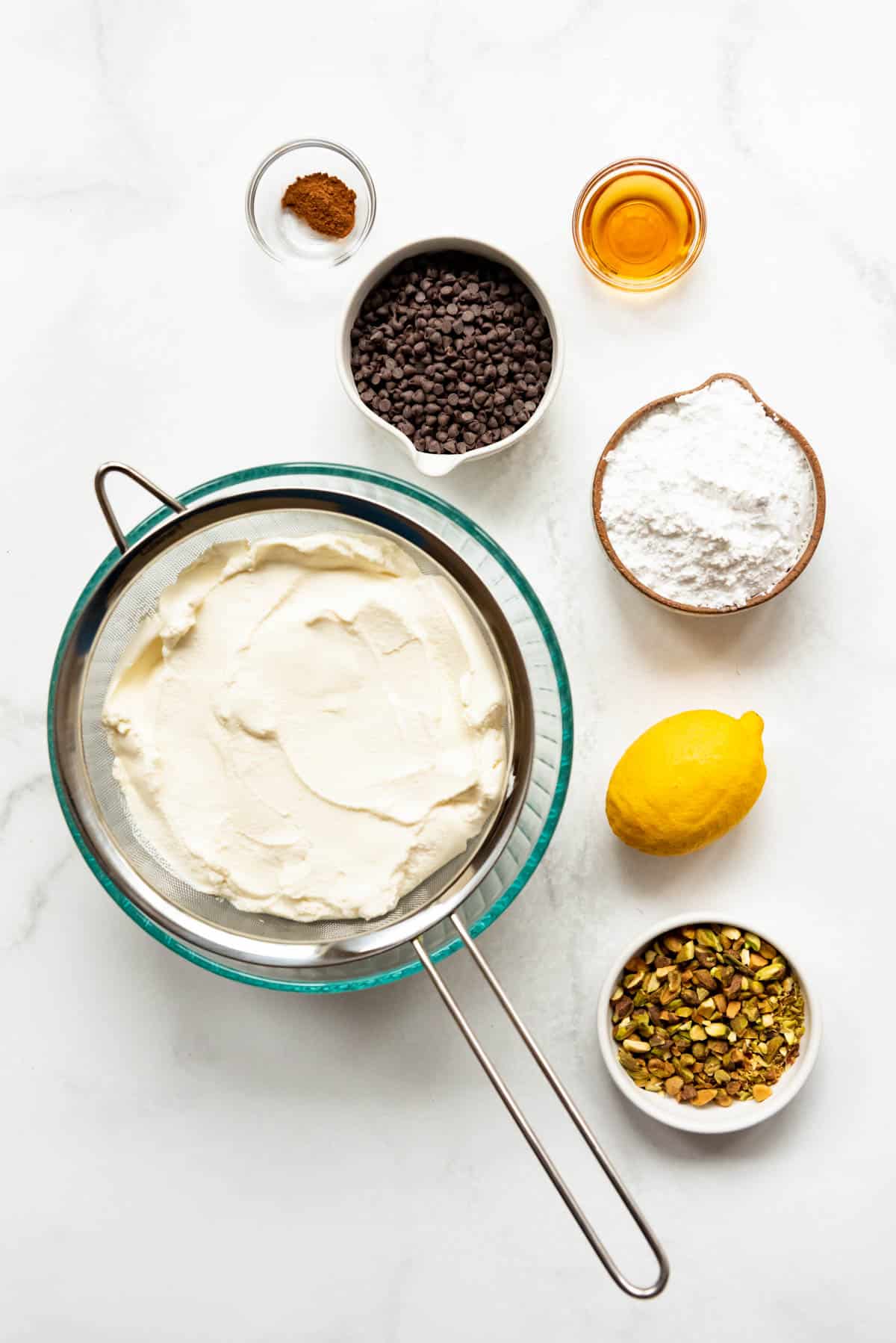
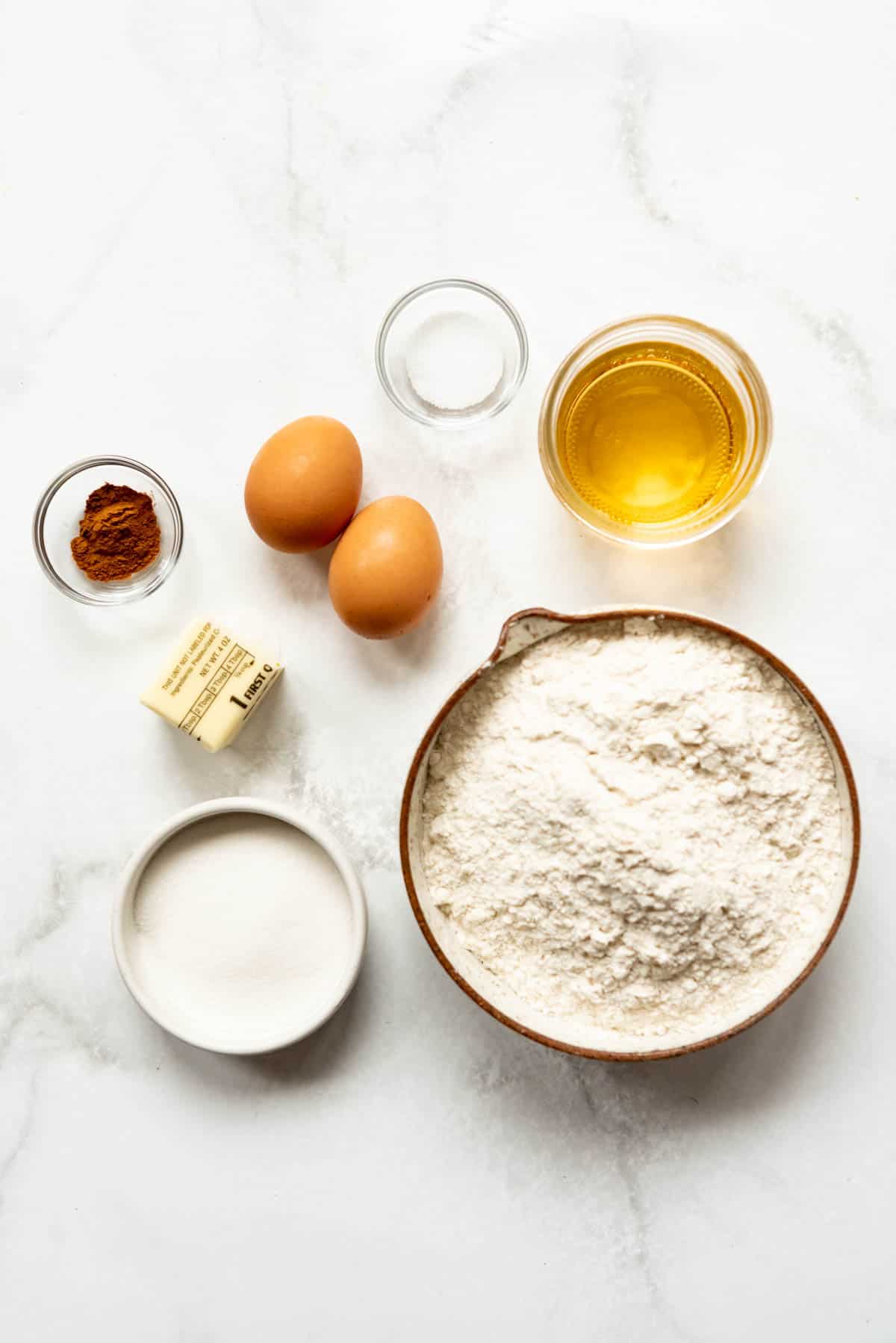
Make Homemade Cannoli Dough
- Make cannoli dough. Combine flour, sugar, cinnamon, and salt in a large food processor (affiliate link). Add butter and pulse until the mixture resembles coarse crumbs.
- Add remaining ingredients. Add eggs and wine, pulsing just until the dough comes together. Transfer to a clean surface and knead until smooth (maybe a few times; it may take up to 10 minutes; add more water if needed).
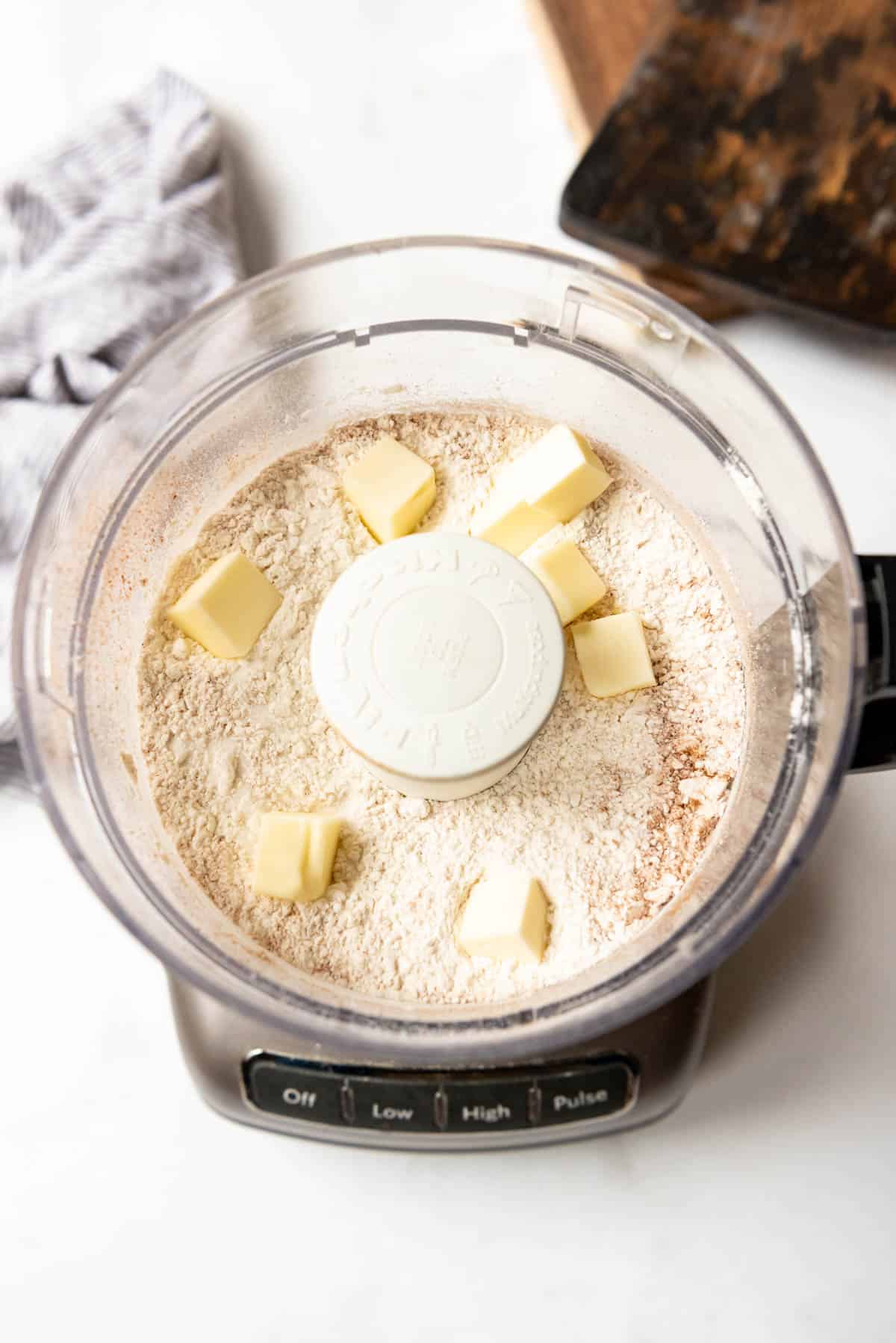
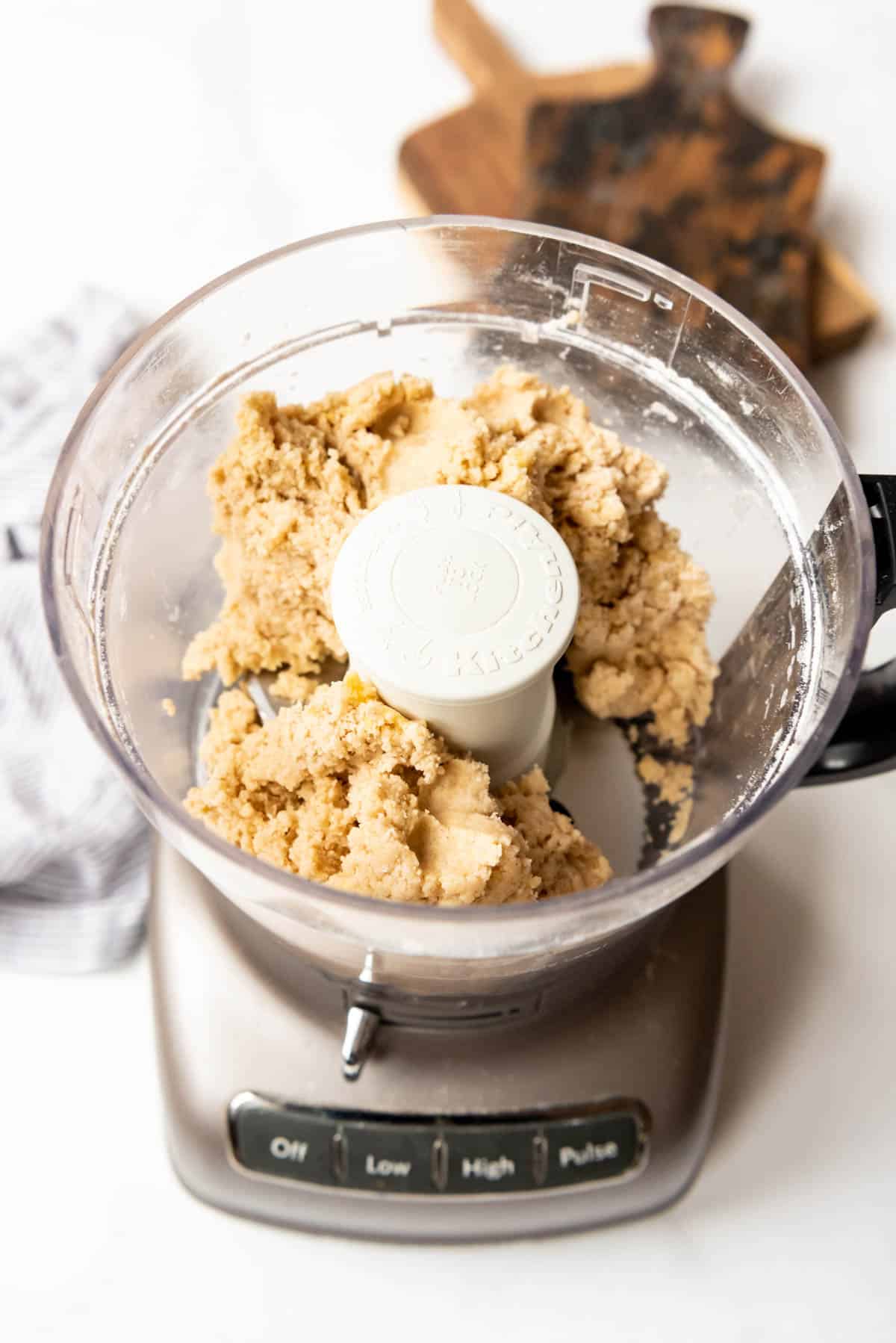
- Cover and chill. Cover the dough with plastic wrap and refrigerate for 1 hour.
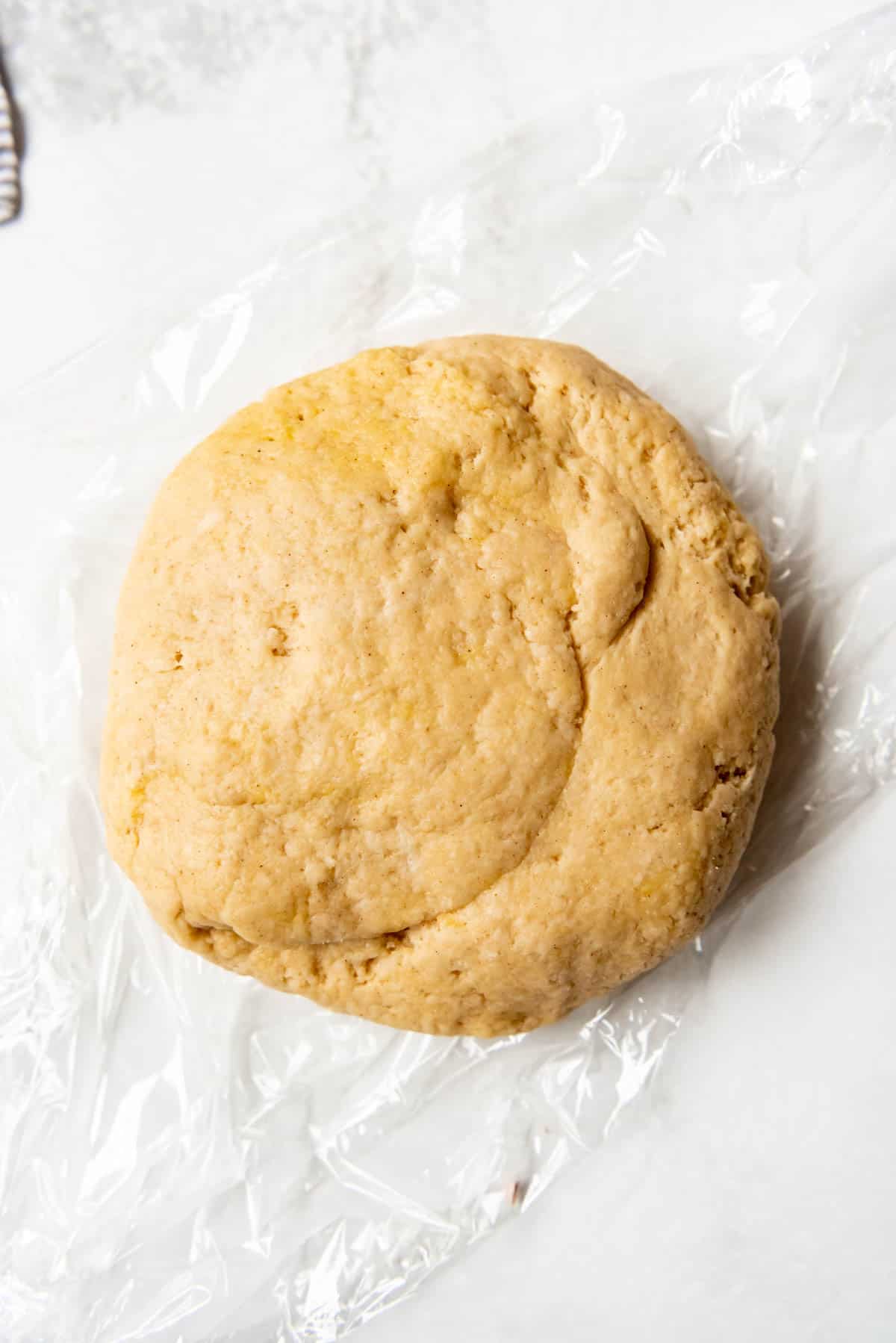
Make Cannoli Filling
- Mix filling ingredients. Combine ricotta cheese, powdered sugar, vanilla, cinnamon, and orange zest in a large bowl.
- Stir and add chips. Stir well, then fold in chocolate chips. Taste and add up to ½ cup additional powdered sugar if you prefer a sweeter filling.
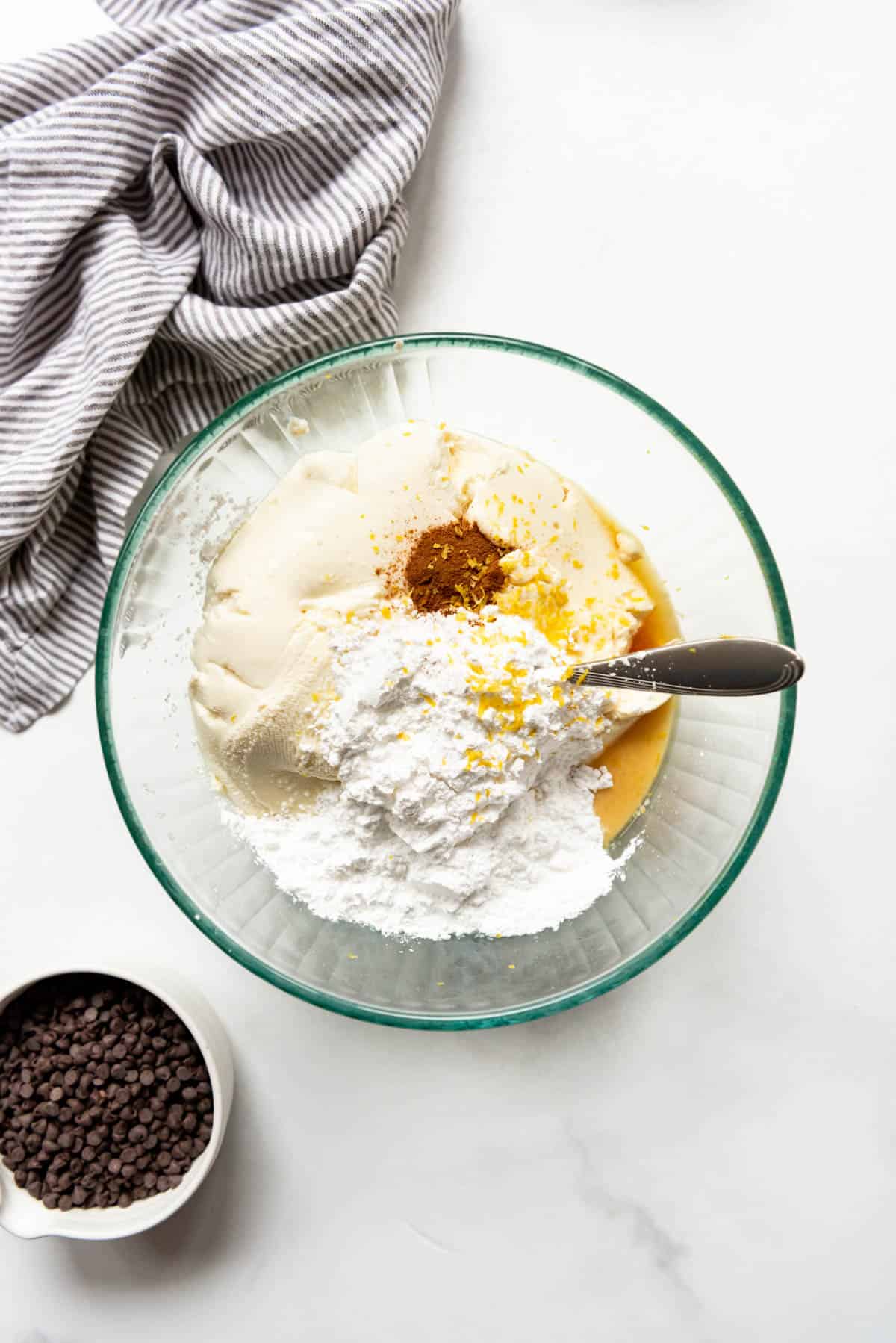
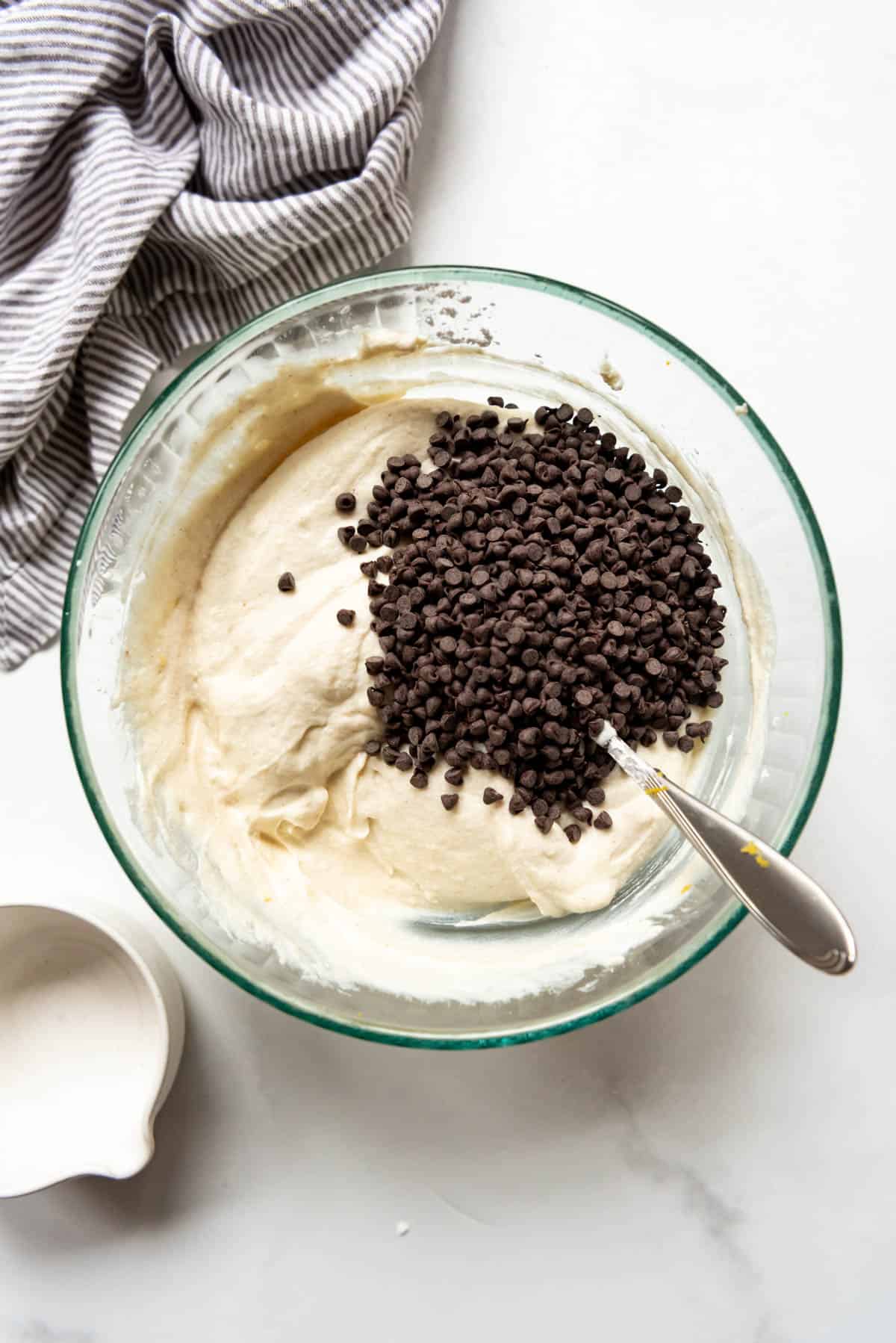
- Cover and chill. Cover with plastic wrap and chill for 2 hours before filling cannoli shells.
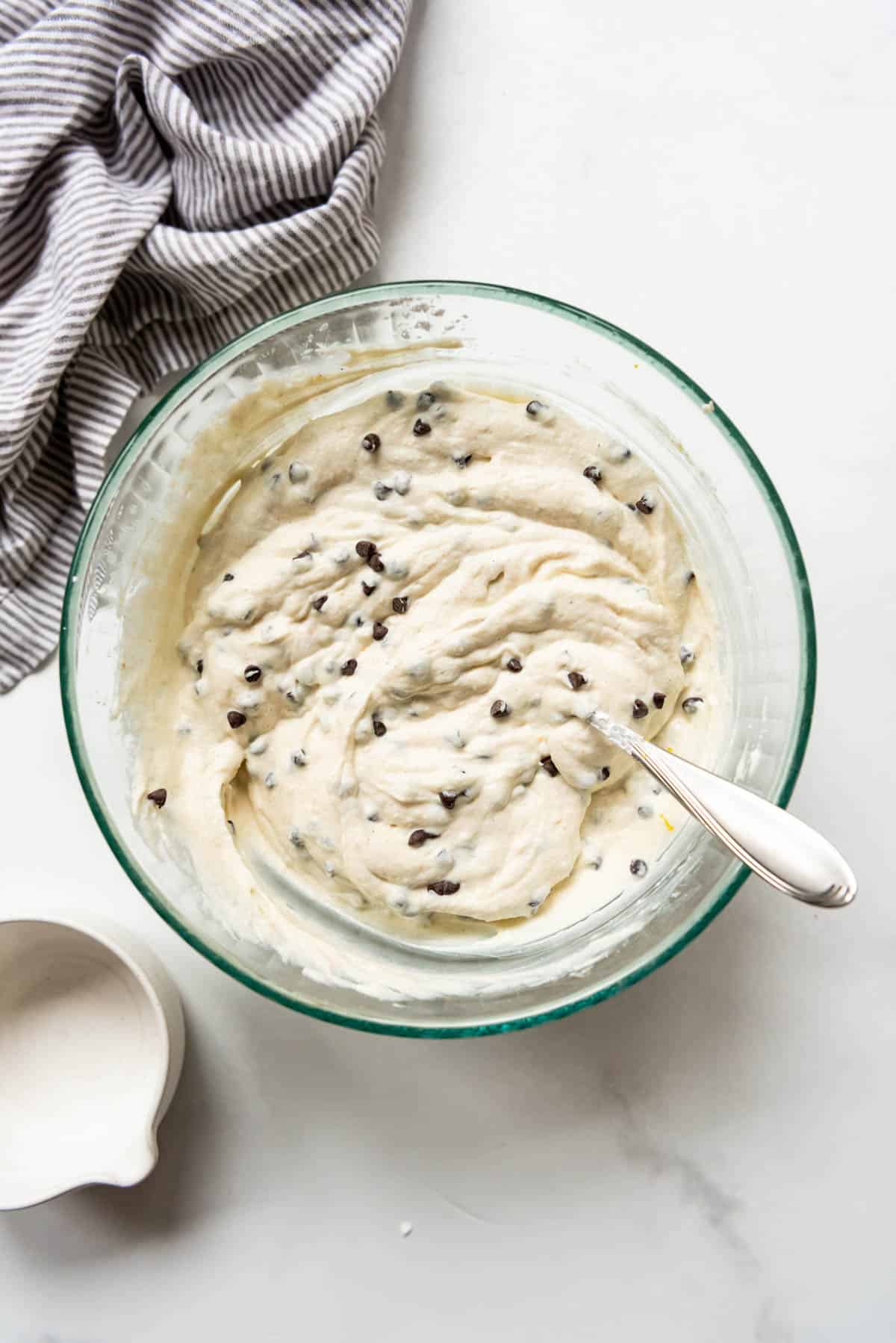
How To Make Homemade Cannoli
- Roll cannoli dough and cut circles out. Roll out the chilled cannoli dough on a lightly floured surface with a rolling pin (affiliate link) until as thin as possible (about ⅛-inch thick). Lightly dust with flour, if necessary. Cover with a damp cloth to prevent the dough from drying out. Cut out 4-inch circles with a round biscuit or cookie cutter. Stretch the circles into 5-inch ovals. Reroll and cut out scraps. Lightly dust the circles with flour to help prevent sticking to the cannoli forms later.
- Make cannoli shells. Wrap each oval of dough around a cannoli form (small metal tubes), overlapping the edges. Brush one edge with egg white, then press the other edge into it to seal it so it doesn't come apart while frying. Repeat with the remaining dough.
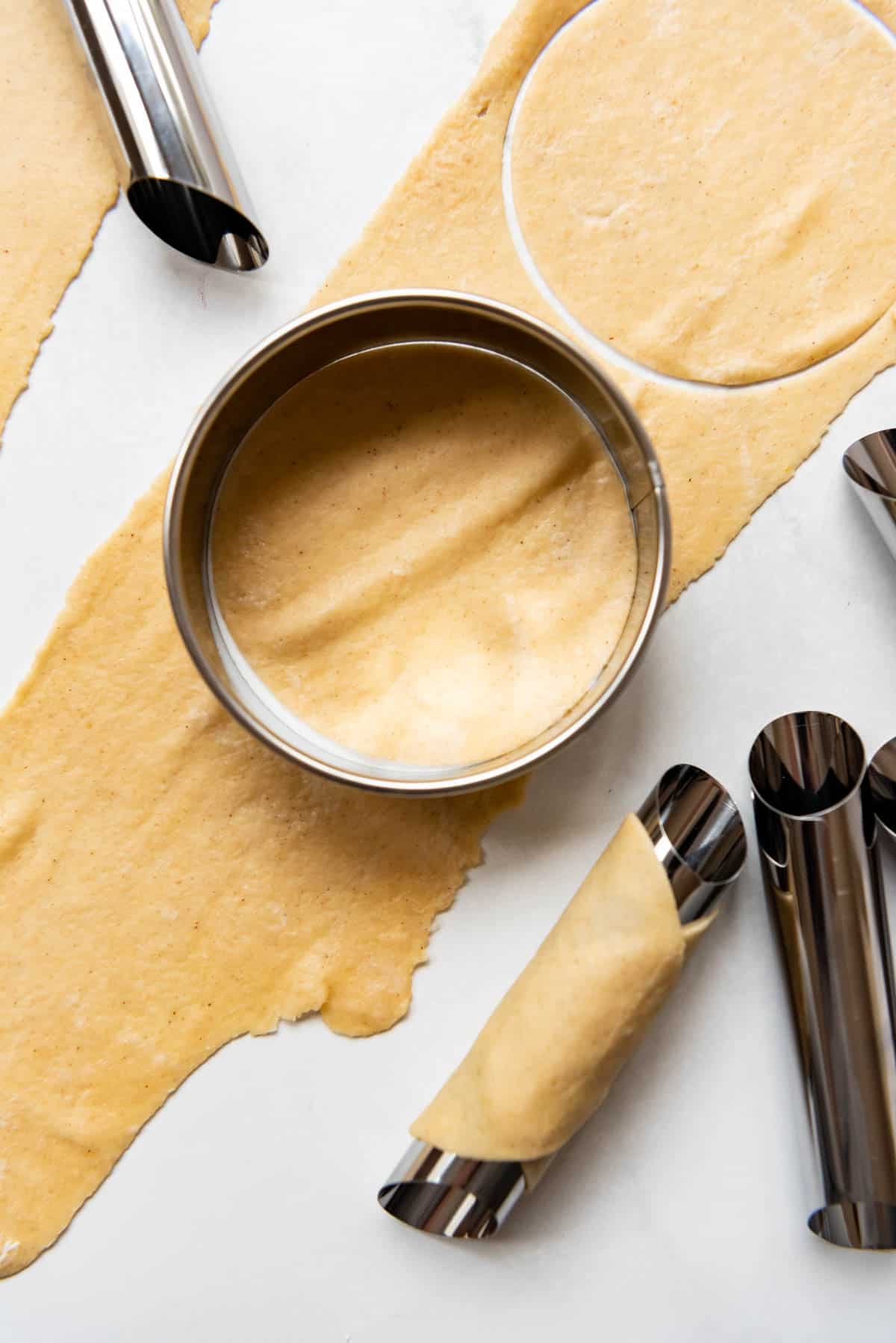
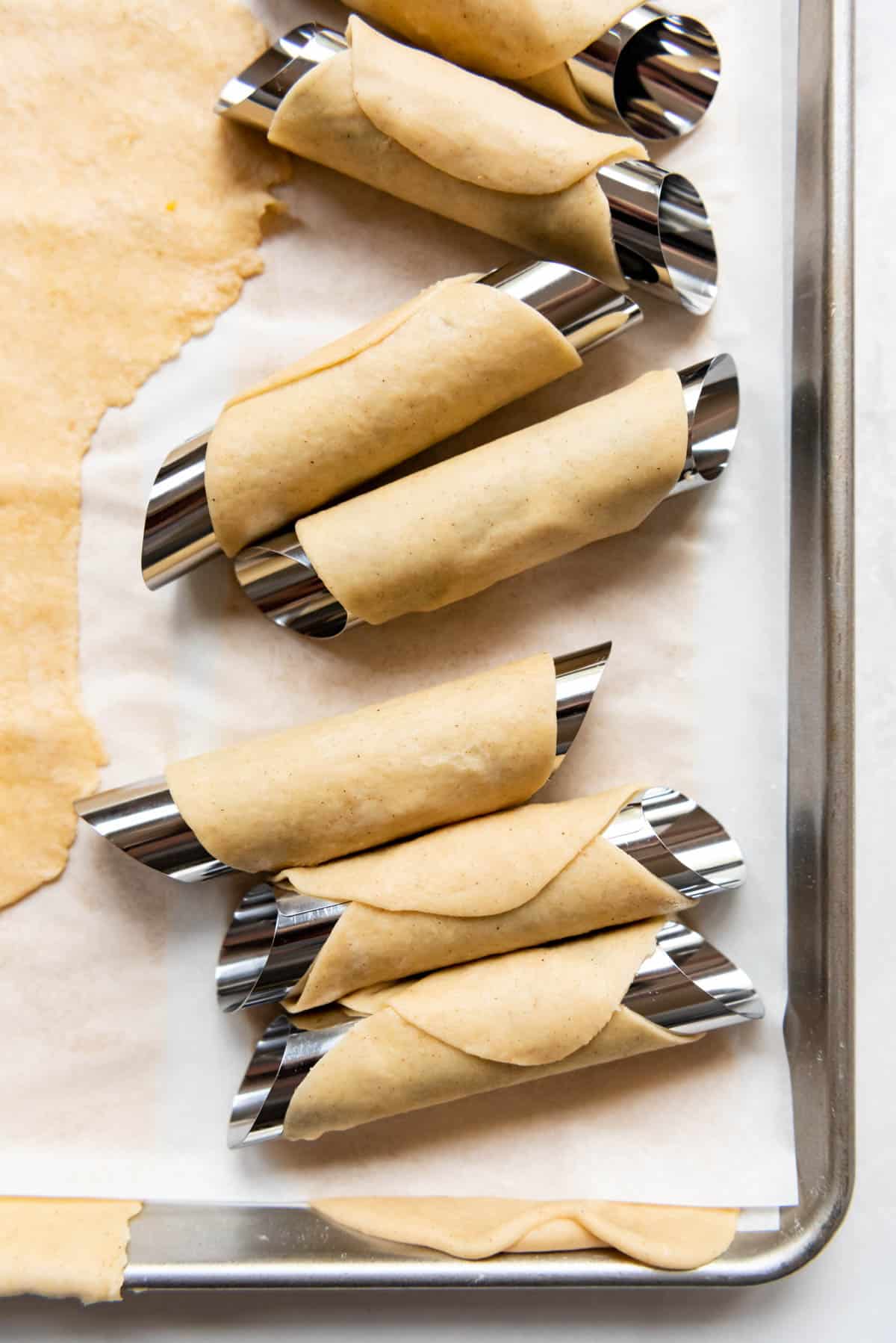
- Deep-fry the pastry shells. Heat 4 inches of oil in a large Dutch oven or deep fryer until it is between 350°F and 375°F. Carefully transfer 3–4 cannoli forms with dough into the hot oil with tongs. Cook for 2-3 minutes until golden brown, then carefully remove and transfer to a wire rack set over a baking sheet to drain and cool. Repeat with the remaining cannoli dough until all the shells have been fried.
- Remove the molds. Remove the molds from the shells while still warm to prevent the cannoli shells from sticking, and cool completely before filling.
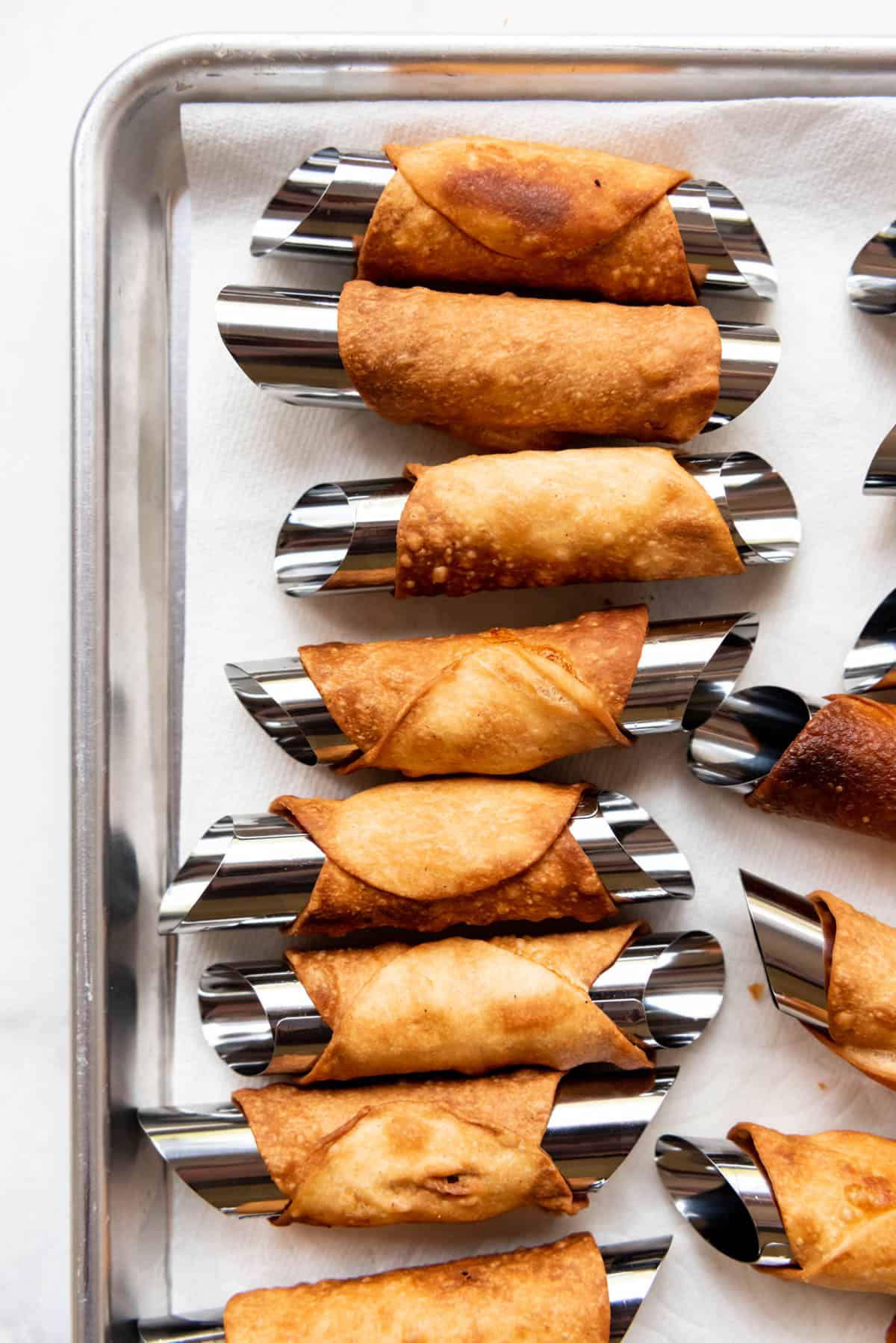

- Fill cannoli shells, decorate, and serve. Transfer the cannoli cream to a piping bag with a large open tip, fill the shells, and sprinkle more mini chocolate chips or chopped pistachios over the ends of each cannoli. Dust it with powdered sugar. I don't recommend filling the cannoli shells with the filling until an hour before serving to prevent the shells from softening.
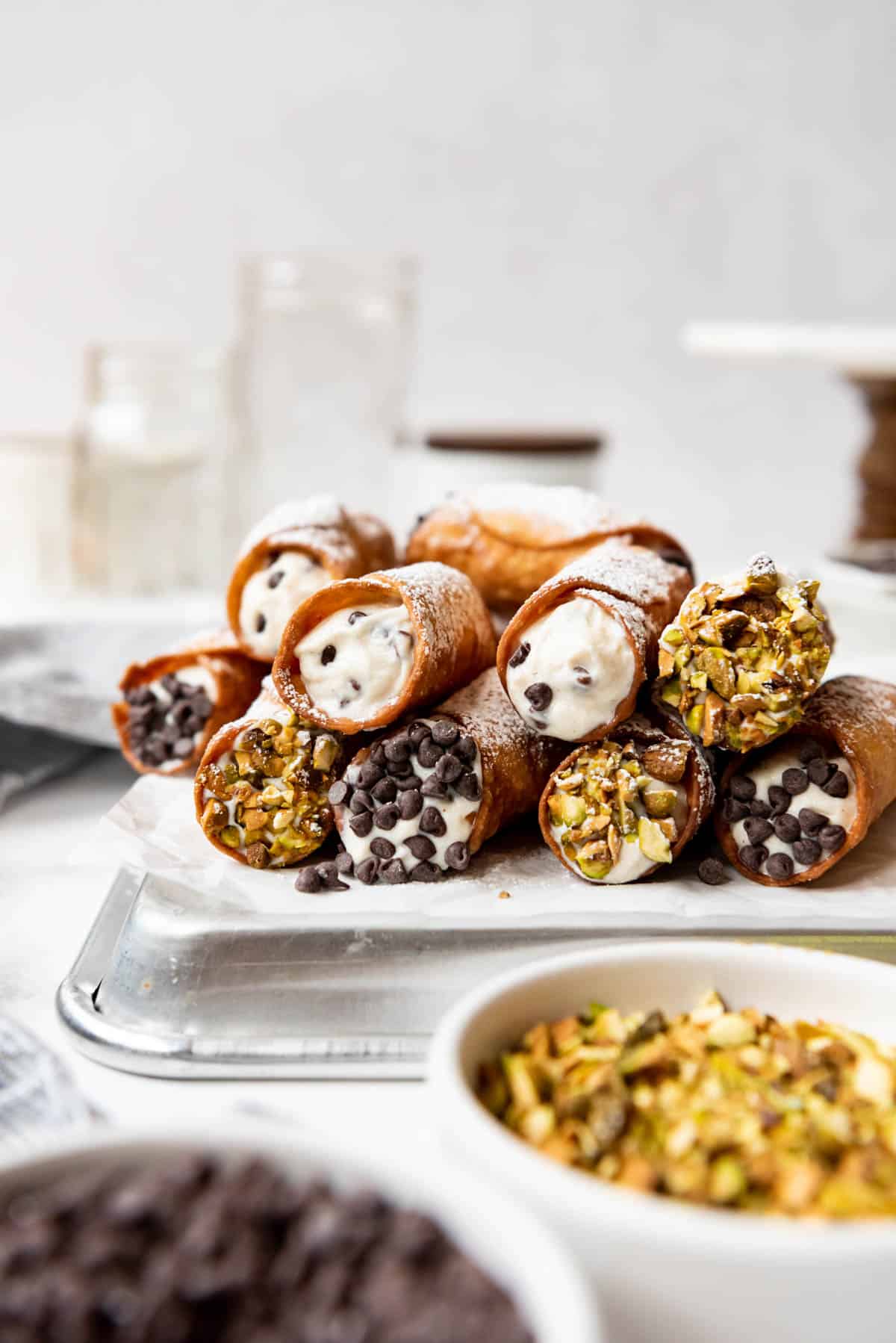
Recipe FAQ's
Authentic cannoli shells are traditionally made with Marsala wine, which both adds flavor and tenderizes the dough for a flaky, crisp cannoli. However, you can replace the marsala wine with grape juice and vinegar, another dry white wine, or sherry.
While traditional cannoli shells are fried, they can be baked as a lighter option, though the texture will be different.
The filling from thie cannoli recipe will keep for 2–3 days in an airtight container in the refrigerator. I do not recommend freezing the filling, as the ricotta cheese becomes watery and separates when thawed. The shells can be made 2-3 days in advance and stored in an airtight container at room temperature. They freeze okay for a few weeks, but they are really best made fresh.
Tips for Success
- The temperature of the oil is critical: too hot, and the shells will burn; too cold, and they'll absorb too much oil and become greasy. Using a deep fryer or a large pot with a candy thermometer (affiliate link) can help you maintain the ideal temperature of 350°F to 375°F.
- It's best to store the shells and filling separately and only fill the cannoli when you're ready to eat them. However, if you have already assembled the cannolis, they can be kept in the refrigerator for a short period, though the shells may soften.
Using a Pasta Machine
You can use a pasta maker to roll consistently thin sheets of dough if you have one. If you're using a pasta maker, divide the cannoli dough into 3 balls. Flatten enough to run through a pasta press. Continue running through progressively thinner settings until the dough is as thin as possible. Remember to dust with flour and/or cover with a damp cloth afterward.
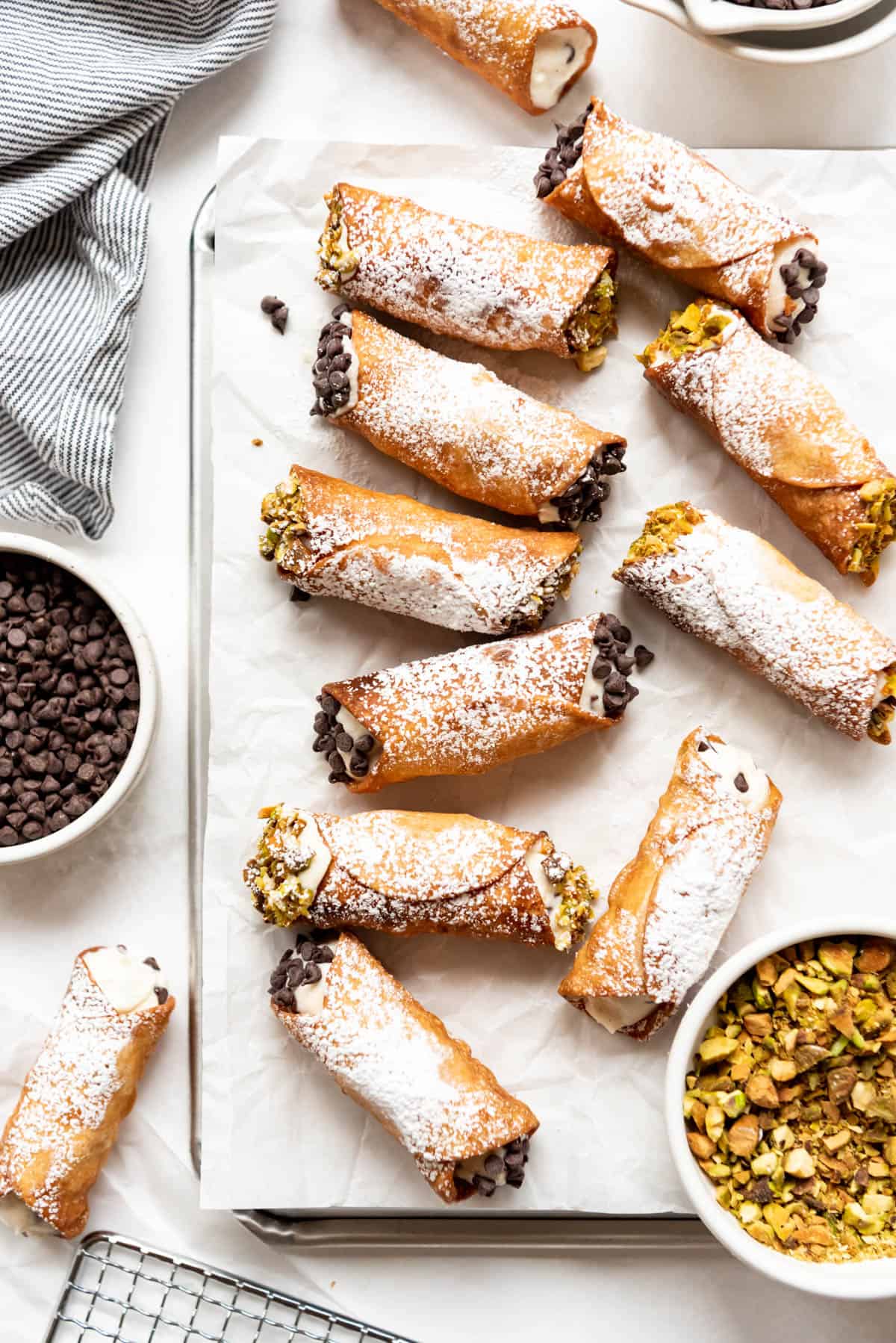
Substitutions and Variations
- Get creative with our cannoli and try other flavors or colors for a different experience or for a special event. Add orange or lemon zest and chopped pistachios for a citrus twist and extra crunch. You can also use other flavored extracts to bring other flavors to these treats. Try almond or peppermint!
- Dip the ends of the cannoli shells into melted chocolate or even brush the insides of each shell with melted chocolate for an extra special finish. When it hardens, it will help prevent the cannoli from getting soggy if you need to fill them ahead of time and take them to an event.
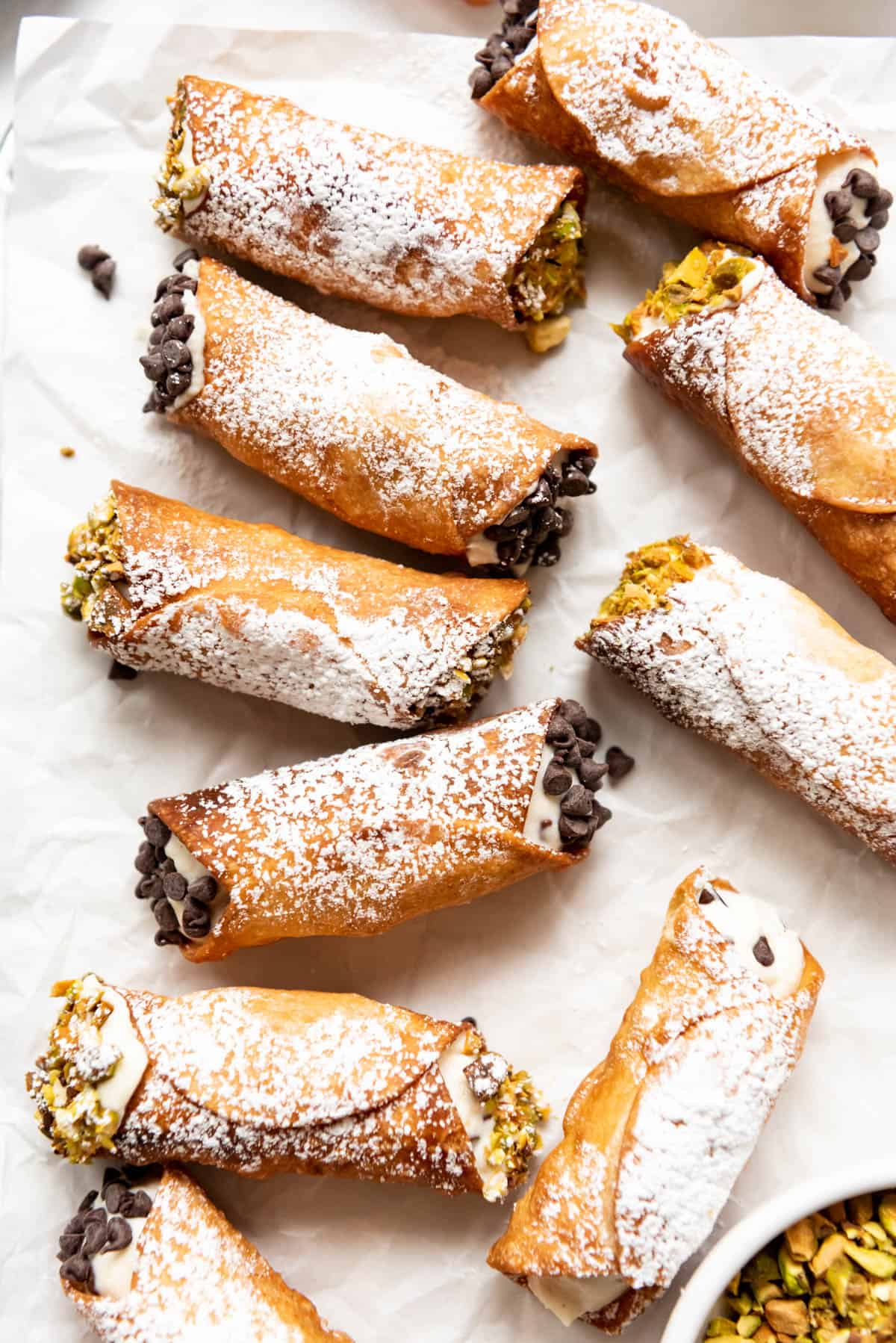
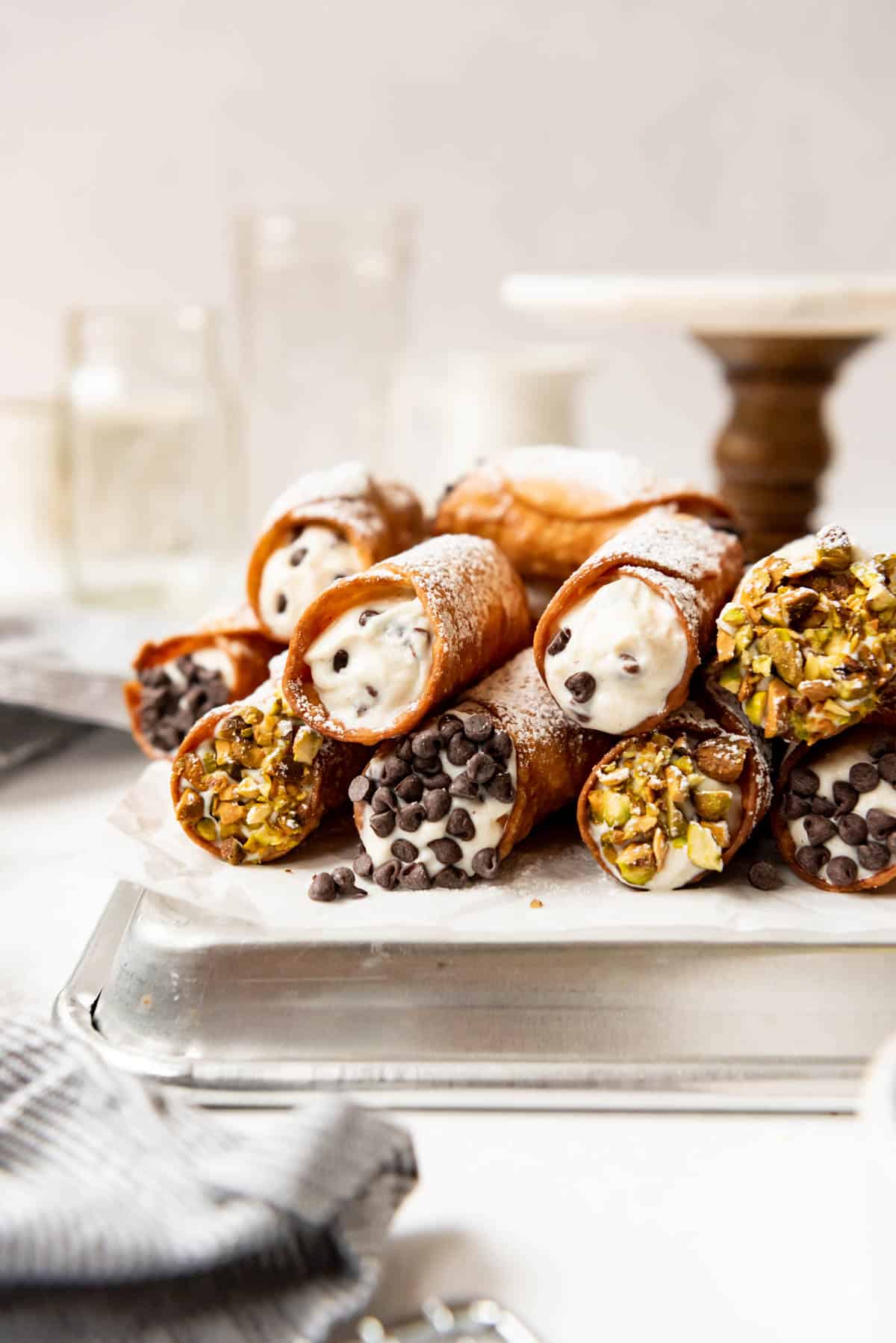
More Dessert Recipes
Sweets & Treats
The Best Churros Recipe
Dessert
Classic Homemade Eclairs
Sweets & Treats
Easy Classic French Cream Puffs
Did you make this recipe?
Let me know what you thought with a comment and rating below. You can also take a picture and tag me on Instagram @houseofnasheats or share it on the Pinterest pin so I can see.
Cannoli
Ingredients
Cannoli Shells
- 3 ½ cups all-purpose flour (438g)
- ¼ cup granulated sugar (50g)
- ½ teaspoon ground cinnamon
- ½ teaspoon salt
- 4 Tablespoons cold salted butter, cubed
- 2 large eggs, separated (1 whole egg + yolk for the dough with 1 egg white reserved for brushing)
- ½ cup sweet Marsala wine, chilled (see note for substitutions)
- Vegetable or peanut oil, for frying (2 quarts or 8 cups)
Cannoli Filling
- 1 (32-ounce) container whole milk ricotta cheese, strained
- 1 cup powdered sugar
- 2 teaspoon vanilla extract
- ¼ teaspoon ground cinnamon
- 1-2 teaspoons orange zest or lemon zest (optional)
- 1 cup mini semisweet chocolate chips
- Chopped pistachios (optional)
Instructions
Cannoli Shells
- Combine flour, sugar, cinnamon, and salt in a large food processor (affiliate link). Add butter and pulse until the mixture resembles coarse crumbs. Add eggs and wine, pulsing just until the dough comes together. Transfer to a clean surface and knead until smooth (maybe be a few times, may take up to 10 minutes - add more water if needed).
- Cover dough with plastic wrap and refrigerate for 1 hour.
- Roll out the dough on a lightly floured surface with a rolling pin (affiliate link) until as thin as possible (about ⅛-inch thick) or use a pasta maker to roll thin sheets of dough.
- ALTERNATIVE: Divide cannoli dough into 3 balls. Flatten enough to run through a pasta press. Continue running through progressively thinner settings until the dough is as thin as possible. Lightly dust with flour, if necessary. Cover with a damp cloth to prevent the dough from drying out.
- Cut out 4-inch circles with a round biscuit or cookie cutter. Stretch the circles into 5-inch ovals. Reroll and cut out scraps. Lightly dust the circles with flour to help prevent sticking to the cannoli forms later.
- Wrap each oval of dough around a cannoli form, overlapping the edges. Brush one edge with egg white, then press the other edge into it to seal so it doesn't come apart while frying. Repeat with remaining dough.
- Heat 4 inches of oil in a large dutch oven or deep fryer until it is between 350°F and 375°F.
- Carefully transfer 3-4 cannoli forms with dough into the hot oil with tongs. Cook for 2-3 minutes until golden brown, then carefully remove and transfer to a wire rack set over a baking sheet to drain and cool. Repeat with remaining cannoli dough until all shells have been fried. Remove molds from the shells while still warm to prevent the cannoli shells from sticking and cool completely before filling.
Cannoli Filling
- Combine ricotta cheese, powdered sugar, vanilla, cinnamon, and orange zest in a large bowl. Stir well, then fold in chocolate chips. Taste and add up to ½ cup additional powdered sugar if you prefer a sweeter filling.
- Cover with plastic wrap and chill for 2 hours before filling cannoli shells.
- Transfer the cannoli cream to a piping bag with a large open tip and fill shells and sprinkle more mini chocolate chips or chopped pistachios over the ends of each cannoli. Dust with powdered sugar. I don't recommend filling the cannoli shells with the filling until an hour before serving to prevent the shells from softening.
Notes
- Yield: This recipe makes about 5 cups of filling. Enough for 40 small or 24 large cannoli.
- Variations: Try adding orange or lemon zest, chopped pistachios.
- Storage: The filling will keep for 2-3 days in an airtight container in the fridge. I do not recommend freezing the filling as the ricotta cheese becomes watery and separates when thawed. The shells can be made 2-3 days in advance and stored in an airtight container at room temperature. They freeze okay for a few weeks, but are really best made fresh.
- How to strain ricotta cheese: If the ricotta is quite thick, you can usually get away with just spreading out a couple layers of paper towel, spreading the ricotta cheese on top, covering with more paper towels, then pressing out excess moisture. For runnier ricotta cheese, place a fine mesh sieve over a large bowl. Line with cheesecloth. Add ricotta cheese and spread into an even layer. Cover with plastic wrap and let it strain for at least 30 minutes but more like 6 to 8 hours or overnight if you have the time. Discard the liquid in the bowl and use the strained ricotta cheese. That's it!
- Optional: You can dip the ends of the cannoli shells into melted chocolate or even brush the insides of each shell with melted chocolate. When it hardens, it will help prevent the cannoli from getting soggy if you need to fill them ahead of time and take them to an event.
- Substitution: If you prefer not to use marsala wine in your shells, you can replace it with grape juice mixed with 1 Tablespoon vinegar.
